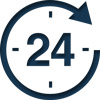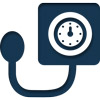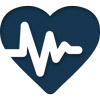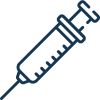Tests & Procedures
All of the following investigations (excluding coronary angiography) can be undertaken on-site and usually within the same clinic visit.

ECG
This is a simple test to look at the electrical signals of the heart. 10 stickers are attached to the body; 6 across the chest and 1 to each limb.
By looking at the electrical patterns that the heart generates then the electrical and muscle health of the heart can be examined.
An ECG may allow for both abnormal heart rhythms and damage to the heart to be detected. Thickening of the heart muscle secondary to high blood pressure can also be looked for.
However, a normal resting ECG does not rule out the possibility of heart disease and further testing may be needed.

Exercise treadmill test
Although a resting ECG may be normal, this may change when the heart is put under stress.
Patients with suspected coronary artery disease (due to ‘furring’ up of the coronary arteries) need to have their ECG examined under stress to see if abnormalities of the ECG suggesting poor blood supply can be provoked.
The stress is normally a treadmill, which starts as a slow walk and depending on the individual’s fitness, can progress to a run at an incline.
The test is terminated when the target heart rate is achieved (between 85-90% predicted), when abnormalities are seen, or at the patient’s request (if undue symptoms are experienced).

Echo scan
An ultrasound of the heart uses sound waves bounced off the heart to build up a picture of both the structure and function of the heart. The test is harmless and uses the same technique as is used to look at babies during pregnancy.
The echo images are then reviewed by a cardiologist to see if there are any abnormalities within the heart muscle (poor function or abnormal thickening), valves (narrowing or leakage) or to look for holes in the upper or lower chambers (ASDs or VSDs).

24 hour tape
Although an ECG can look at the heart rhythm and rate at a given time, it cannot pick up palpitations or heart rhythm problems that are experienced only intermittently.
A 24-hour tape (also known as a Holter monitor) is able to look at the heart rhythm and rate for a prolonged period. This can help in diagnosing the cause of palpitations, dizziness or blackouts, which may either be due to fast or excessively slow heart rates.
If the problem is not found during this assessment then further more prolonged tapes may be needed (occasionally up to 5 or 7 days).
3 stickers are attached to the chest and these are connected by thin leads to a small device the size of an ipod or small mobile phone. The patient is then able to walk around participating in normal daily activities whilst the heart is continuously monitored.

Ambulatory blood pressure monitoring
The diagnosis of hypertension (elevated blood pressure) should only be made after the finding of at least 2 or 3 raised blood pressure recordings on separate days.
Often, however it is difficult to exclude white coat syndrome, when the blood pressure is generally fine, but is raised in the clinic setting due to a stress response to doctors/clinics.
In order to clarify this issue, and also to help look for the response to treatment in patients with true hypertension, it is helpful to record the blood pressure over a 24 hour period. During this test you are fitted with a blood pressure cuff that you take home and wear for the next day and night.
Throughout the recording the cuff becomes tight every 20 minutes (or every hour overnight) to allow an accurate assessment of the blood pressure in a relaxed home setting and throughout a 24 hour period.

Coronary Angiogram
This is an invasive procedure that uses x-rays to examine blood flow to the heart and test how well the heart is pumping.
A cardiologist inserts a thin plastic tube (catheter) into an artery in the wrist or groin. From there it can be advanced into the chambers of the heart or into the coronary arteries to see if there are narrowings. The test is performed with the patient lying flat using local anaesthetic and usually takes around 20 minutes.
Depending on how the whole that is made in the artery is closed, the patient can mobilise soon after the test and is able to go home the same day.
Patients should not eat or drink for 4 hours before the procedure, but should take their usual medication with a sip of water (although patients are usually advised to omit water tablets (diuretics) on that day).
Diabetics are given special advice, particularly those taking metformin or insulin as are patients on warfarin who will need to stop this several days ahead of the test.

Bubble contrast echo study
Some cases of strokes/TIAs, migraines and diving bends have been linked to a small hole in the heart (patent foramen ovale).
This test uses ultrasound (see echo) and injection of agitated salty water to identify whether there is a small hole. In hearts with a small hole the injected microbubbles cross between the chambers of the heart (when normally they do not).
The test is simple, but does involve an injection and takes about 40 minutes.

Ajmaline challenge
This test is undertaken to assess for Brugada syndrome. It is a day case procedure during which an injection of a drug known as Ajamline is given over 5-10 minutes whilst recording the ECG.
The aim of the test is to investigate whether the Brugada ECG can be unmasked by giving this medication in individuals considered at risk for this according to their symptoms or family history. The test should always be discussed in detail, as there is a small but known risk.

Genetic Testing
Many of the inherited cardiac conditions have a clear genetic basis and a gene test can be used to clarify the diagnosis (such as the type of Long QT syndrome), risk stratify (such as those with possible arrhythmogenic cardiomyopathy) or to establish a DNA/gene test to allow screening of the rest of the family (by just taking a blood test)
All genetic tests require a consultation to provide genetic counselling and an explanation of the results.
The genes tested include those for:
Hypertrophic cardiomyopathy
Arrhythmogenic cardiomyopathy
Dilated cardiomyopathy
Long QT syndrome
Brugada syndrome
CPVT
Marfans syndrome/aortopathies
If you are experiencing any of the symptoms above please contact us immediately to arrange an appointment.


